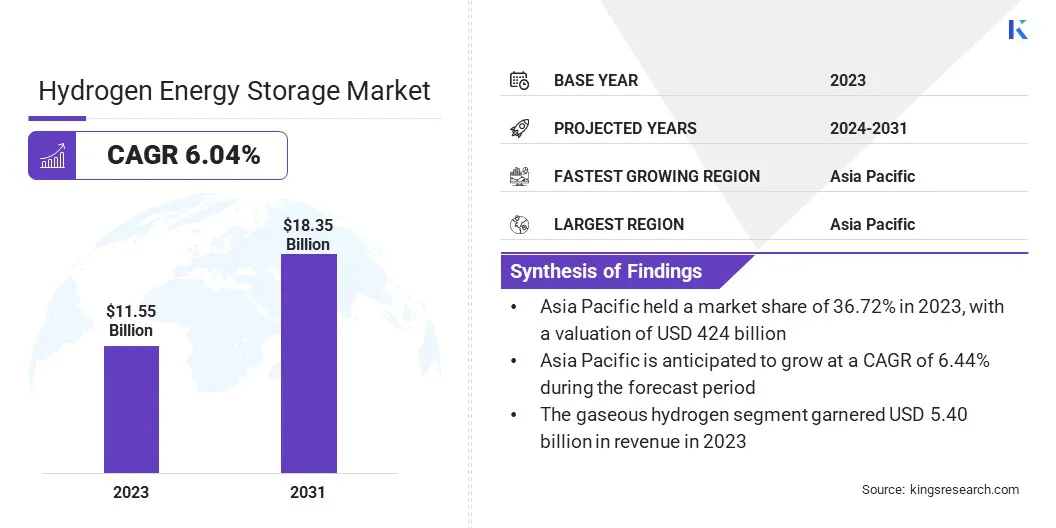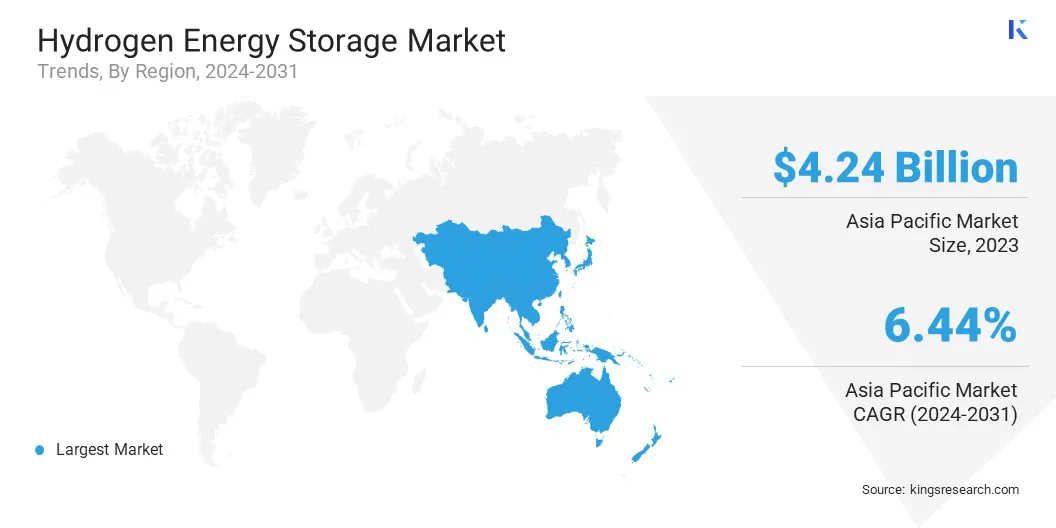Market Definition
The market encompasses technologies and systems that store energy, in the form of hydrogen through processes such as electrolysis. Stored hydrogen is reconverted into electricity using fuel cells or turbines when demand rises. The market includes solid, liquid, and gaseous forms of storage, each tailored to specific energy densities and use cases.
Applications of the market range from grid stabilization and renewable energy integration to the fueling of hydrogen-powered vehicles and supporting industrial operations. The report provides a comprehensive analysis of key drivers, emerging trends, and the competitive landscape expected to influence the market over the forecast period.
Hydrogen Energy Storage Market Overview
The global hydrogen energy storage market size was valued at USD 11.55 billion in 2023 and is projected to grow from USD 12.17 billion in 2024 to USD 18.35 billion by 2031 , exhibiting a CAGR of 6.04% during the forecast period.
The growth of the market is significantly driven by the increasing role of hydrogen in power grid applications, where the market offers reliable solutions for storing excess renewable energy. Additionally, advancements in electrolysis and storage materials are improving the efficiency and affordability of hydrogen production and storage, fueling market expansion.
Major companies operating in the hydrogen energy storage industry are Plug Power Inc., ITM Power plc, Ballard Power Systems Inc., Doosan Fuel Cell Co., Ltd., FuelCell Energy, Inc., Linde plc, Iwatani Corporation, Hydro X, LAVO System, Air Liquide, Cummins Inc., EVE Energy Co., Ltd., Southern California Gas Company, GKN Hydrogen and EnerVenue Inc.
The rising demand for hydrogen as a clean energy carrier is significantly boosting the growth of the market. As countries are accelerating their decarbonization goals, hydrogen is being increasingly adopted across power generation, transportation, and heavy industries.
This surge in demand is driving the need for efficient storage solutions to manage supply variability and ensure availability. Thus, hydrogen energy storage systems are becoming integral to enabling large-scale hydrogen deployment and supporting energy transition strategies worldwide.
- According to the International Energy Agency, the global hydrogen demand increased to 97 million tonnes (Mt) in 2023, marking an increase of 2.5% from 2022. Deployment targets for low-emission hydrogen production technologies are expanding, with projections between 35 to 43 Mt, representing 55-65% of total hydrogen production by 2030, under the Net Zero Emissions (NZE) Scenario.

Key Highlights:
- The hydrogen energy storage market size was valued at USD 11.55 billion in 2023.
- The market is projected to grow at a CAGR of 6.04% from 2024 to 2031.
- Asia Pacific held a market share of 36.72% in 2023, with a valuation of USD 4.24 billion.
- The gaseous hydrogen segment garnered USD 5.40 billion in revenue in 2023.
- The transportation segment is expected to reach USD 8.50 billion by 2031.
- North America is anticipated to grow at a CAGR of 6.22% during the forecast period.
Market Driver
Growing Role of Hydrogen in Power Grid Applications
Hydrogen energy storage is increasingly being integrated into power grids to offer load leveling, frequency regulation, and backup energy capabilities.
Utilities are using hydrogen’s potential for seasonal energy storage, especially in regions experiencing prolonged variability in renewable energy generation. The use of hydrogen for grid flexibility and energy arbitrage is supporting infrastructure modernization and contributing to the growth of the market.
- In April 2025, the Calistoga Resiliency Center is set to become the world’s largest utility-scale and long-duration energy storage project, combining green hydrogen and lithium-ion battery technologies. The center received an investment of USD 28 million from Eagle Point Credit Management. The project aims to supply Calistoga with a reliable backup power source during public safety power shutoffs when PG&E services are unavailable. The system will integrate Energy Vault’s proprietary B-VAULT DC battery technology with hydrogen fuel cells to deliver immediate response and grid-forming capabilities.
Market Challenge
High Costs of Hydrogen Storage Technologies
A significant challenge for the growth of the hydrogen energy storage market is the high cost of storage technologies, especially infrastructure, materials, and maintenance. The cost of developing and deploying hydrogen storage systems like pressurized tanks and solid-state storage solutions, remains a barrier.
To address this, companies are investing in technological advancements, such as improving the efficiency of electrolysis and exploring alternative and cost-effective materials. Additionally, partnerships with government organizations are helping reduce financial burdens through subsidies and incentives, lowering the overall costs and enhancing commercial viability.
Market Trend
Technological Advancements in Electrolysis and Storage Materials
Improved electrolyzer efficiency, reduction in system costs, and innovations in hydrogen storage materials, such as metal hydrides and liquid organic hydrogen carriers are transforming operational feasibility.
These advancements are improving energy density, enhancing safety, and reducing storage footprint. The increasing technical viability of hydrogen storage solutions is enhancing commercial attractiveness and contributing to the growth of the market.
The International Association for Hydrogen Energy emphasizes the promising role of water electrolysis as a sustainable method for splitting water into hydrogen and oxygen, offering substantial potential across research and industrial domains.
Progress in electrolyser technologies, such as alkaline water electrolysers (AWE), proton exchange membrane electrolysers (PEMWE), anion exchange membrane electrolysers (AEMWE), solid oxide electrolyser cells (SOEC), and proton-conducting ceramic electrolysers (PCCEL), has significantly enhanced performance and cost-effectiveness.
The electrolyser stack, comprising two electrodes separated by a membrane or diaphragm is essential for advancing clean hydrogen adoption.
Hydrogen Energy Storage Market Report Snapshot
|
Segmentation
|
Details
|
|
By Storage Form
|
Gaseous Hydrogen, Liquid Hydrogen, Solid Hydrogen
|
|
By Application
|
Transportation, Stationary Power, Industrial
|
|
By Region
|
North America: U.S., Canada, Mexico
|
|
Europe: France, UK, Spain, Germany, Italy, Russia, Rest of Europe
|
|
Asia-Pacific: China, Japan, India, Australia, ASEAN, South Korea, Rest of Asia-Pacific
|
|
Middle East & Africa: Turkey, UAE., Saudi Arabia, South Africa, Rest of Middle East & Africa
|
|
South America: Brazil, Argentina, Rest of South America
|
Market Segmentation:
- By Storage Form (Gaseous Hydrogen, Liquid Hydrogen, Solid Hydrogen): The gaseous hydrogen segment earned USD 5.40 billion in 2023 owing to its well-established storage infrastructure and cost-effectiveness in large-scale applications.
- By Application (Transportation, Stationary Power, Industrial): The transportation segment held 42.74% of the market in 2023, due to the growing demand for clean, efficient, and long-lasting storage solutions in vehicles, especially for fuel cell-powered vehicles.
Hydrogen Energy Storage Market Regional Analysis
Based on region, the global market has been classified into North America, Europe, Asia Pacific, Middle East & Africa, and South America.

The Asia Pacific hydrogen energy storage market share stood at around 36.72% in 2023 in the global market, with a valuation of USD 4.24 billion. The market is making progress, driven by the development of large-scale hydrogen hubs, powered by the region’s solar and wind resources.
Located near major industrial zones and port infrastructures, these hubs facilitate the conversion of surplus renewable energy into storable hydrogen through advanced electrolysis. Simultaneously, the market is gaining momentum through efforts taken toimplement renewable energy systems in remote areas, including high-altitude research facilities, isolated islands, and off-grid industrial areas.
This growing need for clean and long-duration storage is driving compact and climate-resilient hydrogen storage technologies best suited for Asia Pacific’s diverse terrains, strengthening the growth of the market.
- In March 2025, China introduced its hydrogen fuel cell technology in Antarctica, representing a major milestone in advancing renewable energy solutions in extreme environments. The system, developed by theThis technology, developed by a subsidiary of China’s State Power Investment Corporation, was successfully installed at the Qinling Station. It operates by utilizing surplus electricity generated from strong wind and solar conditions to produce hydrogen, which is stored and used as a reliable energy source during periods of low renewable output.
The North America market is poised for significant growth at a robust CAGR of 6.22% over the forecast period. The development of hydrogen refueling stations along North America’s key freight corridors is boosting the hydrogen energy storage industry. Storage systems are becoming an integral part of refueling stations to ensure hydrogen availability when needed, especially during peak demand periods.
This expansion supports the transition to hydrogen-powered transportation, contributing to the market’s growth, as storage technologies scale up to meet the needs of the freight and mobility sector. Furthermore, research into large-scale underground hydrogen storage solutions, such as salt caverns, is a major factor driving the growth of the market in North America.
Regulatory Frameworks
- The U.S. Department of Energy (DOE) provides guidelines on hydrogen storage and detailing methods such as high-pressure gas storage, cryogenic liquid storage, and solid-state storage. These guidelines are crucial for ensuring safety and efficiency in hydrogen storage systems. The Inflation Reduction Act (IRA) offers tax credits for clean hydrogen production, which indirectly support hydrogen storage projects, by making green hydrogen more cost-effective.
- The European Union establishes criterias for renewable hydrogen, requiring a minimum of 70% greenhouse gas emissions compared to fossil fuels. These standards influence the development of hydrogen storage systems in alignment with sustainability goals. The EU's Hydrogen and Decarbonised Gas Market aims to create a dedicated infrastructure for hydrogen, including storage facilities, to support a competitive hydrogen market.
- In the UK, The Gas Safety (Management) Regulations 1996 mandates that operators of hydrogen storage facilities submit safety cases to the Health and Safety Executive (HSE), ensuring risks are properly managed.
- In Japan, the Hydrogen Society Promotion Act 2024, regulates hydrogen-related businesses, including storage, to promote a hydrogen-based society. Japan offers subsidies for hydrogen production and storage projects, aiming to increase the annual hydrogen supply to 3 million tonnes by 2030.
Competitive Landscape:
Market players are engaging in collaboration with national research bodies and energy laboratories to advance solid-state hydrogen storage technologies.
These collaborations are often backed by government funding and support, allowing companies to test and refine their solutions in real-world energy systems. At the same time, firms are investing heavily in R&D to enhance the efficiency, safety, and scalability of storage technologies.
- In November 2024, Southern California Gas Co. and GKN Hydrogen collaborated with the U.S. DOE's National Renewable Energy Laboratory (NREL), and launched a demonstration project to test an advanced solid-state hydrogen storage solution. Hosted at NREL’s Flatirons Campus in Colorado, the initiative utilizes GKN Hydrogen’s metal hydride technology to store hydrogen in solid form rather than traditional gas tanks. The project is designed to assess the integration of storage method with clean energy systems, like microgrids or fuel cells, and explore optimal applications for renewable hydrogen in solid-state form.
List of Key Companies in Hydrogen Energy Storage Market:
- Plug Power Inc.
- ITM Power plc
- Ballard Power Systems Inc.
- Doosan Fuel Cell Co., Ltd.
- FuelCell Energy, Inc.
- Linde plc
- Iwatani Corporation
- Hydro X
- LAVO System
- Air Liquide
- Cummins Inc.
- EVE Energy Co., Ltd.
- Southern California Gas Company
- GKN Hydrogen
- EnerVenue Inc.
Recent Developments (Partnerships/Expansion)
- In December 2024, EnerVenue partnered with RWE to supply its next-generation nickel-hydrogen battery technology for a pilot project at RWE’s testing facility in Milwaukee. The batteries, introduced in September 2023, were deployed as energy storage vessels (ESVs) and tested to evaluate their performance. This initiative enabled EnerVenue to demonstrate the capabilities of its metal-hydrogen storage technology for long-duration applications and aligned with its goal of validating the commercial potential of the latest energy storage solutions.
- In April 2024, White Martins established a second electrolyzer facility to supply green hydrogen in southeastern Brazil. Located in Jacareí, São Paulo, the five-megawatt pressurized alkaline electrolyzer plant is powered by locally sourced solar and wind energy. The hydrogen produced at the site is independently certified as green, supporting the region’s transition to cleaner energy.


